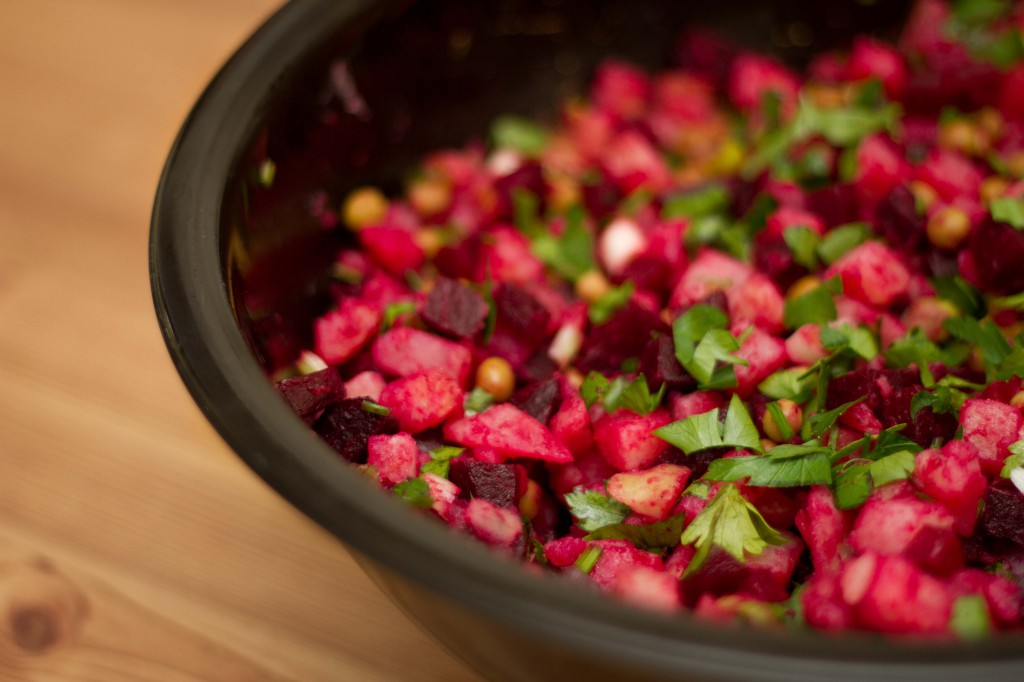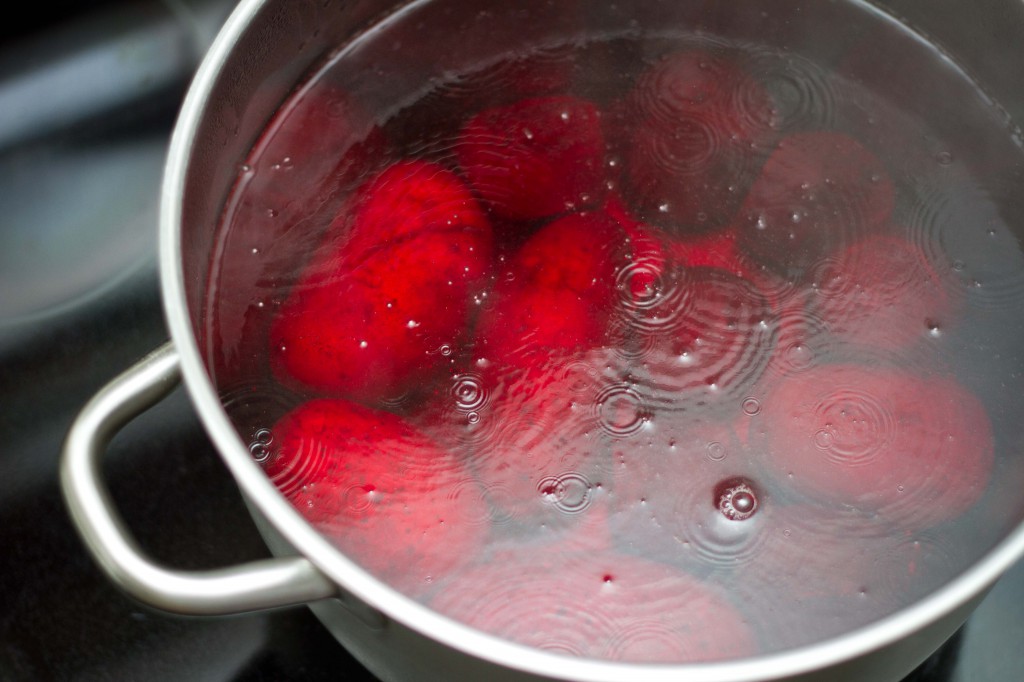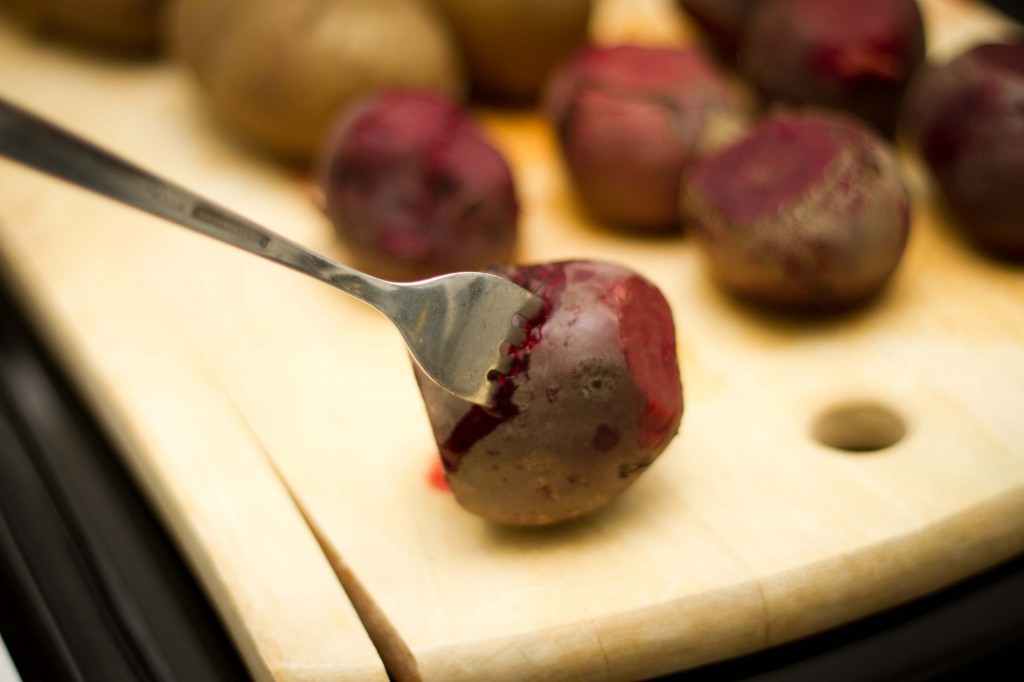Want to cook a Russian dish? Try Vinegret! Posted by Jenya on Nov 26, 2014 in Culture
Vegetarians, vegans and healthy eaters rejoice! This recipe is among my favorites because it is nutritious, delicious, and fairly hard to mess up. You can either serve it by itself, use it as a salad, or even a side dish with any meat or fish.
There is no consensus on the internet regarding the origins of this dish but most sources tend to agree that it was probably borrowed from Germany around 19th century. The details of the story get really fuzzy when it comes to the name. Supposedly, the emperor’s chef, who was French, asked if the dish contained vinegar and the people making it nodded in agreement saying “vinegret, vinegret” – since then this salad officially became known as vinegret. Go figure…
Before we begin, lets gear up! Get out a big pot, a cutting board, a knife, and an apron (unless you are OK with beet stains on your clothes). Next, we’ll gather up the ingredients (this recipe make about 8 servings).
Ингредиенты:
2 большие или 4 маленькие свеклы
3-4 большие картофелины
1 банка зеленого горошка
половина луковицы (или 2-3 стрючка зеленого лука)
от ¼ до ½ стакана кислой капусты (можно заменить укропом и/или петрушкой)
Заметка: на фото показана петрушка, так как у меня не было кислой капусты, но вообще я предпочитаю винегрет с кислой капустой
3 ст. л. оливкового или подсолнечного масла
3 соленых огурца
соль, перец на вкус
от ¼ до 1 ч. л. уксуса, по желанию
Приготовление:
1. Помойте свеклу и картошку. Если свекла крупная, разрежьте на четвертинки. Отварите картошку и свеклу в кожуре; варите до тех пор, пока вилка не будет с легкостью входить внутрь. Обратите внимание на то, что свекла иногда варится дольше, поэтому время от времени проверяйте овощи вилкой.
2. Пока картошка и свекла готовятся, мелко нарежьте лук и соленые огурцы. В большой миске смешайте лук, горошек, огурцы и капусту (или укроп с петрушкой).
3. Когда картошка и свекла будут готовы, выложите их на разделочную доску до полного остывания. Затем очистите и мелко нарежьте, как показано на фото.
4. Смешайте свеклу и картошку с остальными ингридиентами. Добавте масло, соль,перец и уксус по вкусу.
5. Охладите от 1 до 2 часов.
Приятного аппетита!
Ingredients:
½ medium onion (or 2-3 spring of green onion)
¼ to ½ cup sauerkraut (preferably Russian style) or dill/parsley to taste
Note: you see parsley in the photo because I did not have any sauerkraut at the time, but I personally like it better with sauerkraut.
3 Tbsp. olive or sunflower oil
3 pickles (or 5-6 pickle spears)
¼ to 1 tsp vinegar, optional
Preparation:
1. Start by washing beets and potatoes. If using large beets, cut in quarters. Boil potatoes and beets (skin on) in a large pot until the fork goes in easily. Keep in mind, beets might take longer to cook, so check your veggies periodically.
2. While potatoes and beets are cooking, finely chop the onions and pickles. In a large bowl combine onions, peas, pickles, and sauerkraut (or dill/parsley)
3. Once potatoes and beets are cooked, lay them out on a cutting board to cool off. Once cool, peel the skin off and cut in small pieces, as shown.
4. Mix beets and potatoes with the rest of the ingredients. Add oil, salt, pepper, and vinegar to taste.
5. Refrigerate for 1-2 hours.
Note: винегрет is usually best the next day, once the flavors had a chance to marry :-). The nonsense on Wikipedia page about it not being safe the next day is very aggravating. Ugh….
Enjoy!

Build vocabulary, practice pronunciation, and more with Transparent Language Online. Available anytime, anywhere, on any device.










Comments:
trevar:
Are there many vegetarian Russian recipes
Jenya:
Trevar, I believe there are plenty 🙂 .
Anya:
Yes, Trevar. There are a lot. There are also a number of dishes that normally contain meat but that you can make without. Olivye salad is just as good without the meat, borscht is just as good with veggie broth instead of stock, and peroshki with cabbage or potato fillings instead of with фарш. Russian cuisine actually lends itself very nicely to a vegetarian diet.
Jenya! Thank you for posting this. I have recently been re-exploring my childhood memories of favorite foods, and I had forgotten about vinegret! I will be buying beets next time I go to the grocery. 🙂
Nina Grigorivna:
I so love Vinegret! My mom made it often when I was growing up. She used home-cooked beans of whatever sort she happened to have on hand instead of or in addiiton to the peas.
I recall, when I was a very little girl, the village would have a harvest at the beginning of autumn where hogs and other animals were butchered and meat was made in hams, sausages, canned meat and all sorts of other items. Everyone contributed food, pot-luck type, and my mom made the first vinegret I ever recall. That, and a roasted pig ear or tail … heaven!
Eugene:
The translations should alternate with the source materials, not be placed all at the end. That’s much easier to work with rather than switch back and forth wasting time. Thanks, Gene S.